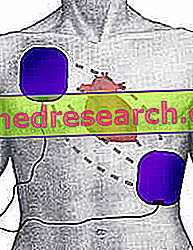Avena Sativa
Oat is a cereal intended for both animal and human nutrition. The most widespread variety is Avena sativa, a plant belonging to the Gramineae family, widely cultivated throughout the planet; on the other hand, sifting through the old "Anglo-Saxon" texts it is possible to find numerous quotations concerning the culinary application of oats;

Oat is a predominantly carbohydrate food but, unlike most cereals, it also boasts a fair amount of protein; on the contrary, the bran separated during dehulling is more caloric, less protein and less rich in magnesium and iron than wheat.
Nutritional properties
It is a drink that is improperly used as a substitute for cow's milk.
It is a common belief that oats can significantly reduce LDL cholesterol but, in reality, this feature is by no means a prerogative of oats! Or better ... oat is one of the many foods that contains hypo-cholesterol-lowering molecules: in this case the β-glucans. These are components of soluble fiber (contained above all in vegetables and fruit), which also appears to be present in good quantities in refined oats.
NB . Oat bran contains 3 TIMES LESS FIBER than wheat, although according to current food composition tables, it is not possible to study the breakdown between soluble and insoluble component. However, oat milk CANNOT possess the same cholesterol-lowering characteristics due to the daily consumption of oat seeds, as most of the dietary fiber is removed during the production of the drink itself; certainly also in oat milk there are small amounts of β-glucans ... but certainly not superimposable to the levels contained in the solid food.
In this regard, the reader does not allow himself to be mislead by the colorful "vegan" descriptions of oat milk, which is often labeled as a food rich in fiber: it contains 0.8 g / 100 ml. This means that, by drinking oat milk, to introduce the quantity of dietary fiber typical of "a mixed salad", at least 300ml should be swallowed (therefore triple)! While to reach the contribution of a portion of "aubergines to the mushroom", our stomach should accommodate 850 ml of oat milk. A little too much!
On the other hand, oat milk contains tocopherols (vitamin E) and folic acid; although probably (lacking specific data) not in considerable quantities.
Oat milk is defined as "low in calories"; in fact the one on the market has from 47 to 49kcal / 100ml against the 66kcal / 100ml of whole cow's milk, although it is not said that it is a desirable feature ... after all it is a food and not water!
Compared to the animal product, oat milk contains:
- more carbohydrates (it is glucose or maltose and not lactose as in the vaccine product)
- half of the proteins
- half of the lipids.
At the industrial level, the latter are added through the addition of sunflower oil; therefore they consist mainly of INSATURE chains (compared to the SATURE chains of cow's milk). NB . Oat milk does NOT contain cholesterol (present in quantities of about 10 mg / dl in whole cow's milk).
COMMERCIALIZED oat milk can contain energized water, which is a magnetized liquid. It is said that the energized water boast features: purifying, diuretic, anti-lithiasis and hepatic-stimulants ... but personally I would not make it a therapy! Furthermore, oat milk contains sea salt and thickener additives (such as E407 carrageenan - obtained by boiling north-Atlantic seaweed).
NB . Mineral salts and vitamins can be added by fortification.
Produce oat milk
Oat milk can be purchased but also produced at home; for the more curious readers it is possible to experiment the drink using the following recipe (one of the best known), of which there are however several variations. NB . From the organoleptic point of view, the following oat milk has nothing to do with the industrial product; the smell in particular is pungent and characteristic.
Oat milk - 1 liter
Ingredients | ||
oat flour | 500g | |
water | 1000ml | |
Banana | 150g | |
Aromas | vanillin or anise or cinnamon etc. | |
Cooking salt | 3-5g | |
Maple syrup | QB | |
Alternatively you can follow the recipe of our personal cooker, Alice:
Avena's milk
X Problems with video playback? Reload from YouTube Go to Video Page Go to Video Recipes Section Watch the video on youtubeMethod
Blend everything and filter with a twisting torch.
This recipe includes a fruit (banana) useful both as a thickener and as a flavoring (together with the aromas and maple syrup) as, in itself, water and oat flour would constitute a drink that is nothing short of unattractive.
In this regard, I personally believe that:
- adding pectin instead of banana
- the addition of 10g of fructose or 20g of honey per liter
- the use of little vanillin
can be a decidedly better nutritional and taste solution.
As can be seen by scrutinizing the ingredients, there is no fat component. This is because, unlike the food industries, the consumer would not be able to create a true emulsion-suspension (like that of cow's milk, for example); if we tried to add sunflower oil to the "pappone", even blending long, all the oil would emerge in very unpleasant superficial bubbles. However, if we wanted to make an attempt anyway, rather than sunflower oil I recommend that of flax or soybean oil (due to the high content of omega-3), provided that the resulting oat milk is consumed in the very short term !
Oat milk is a drink to be consumed ONLY if appreciated and I do not attribute it to a balanced diet. It is advisable to use it for lactose intolerant or allergic to cow's milk proteins, but only in the event that they cannot give up the classic drink; moreover, we recall that: oat milk, as well as other plant milks, nutritionally speaking does NOT present absolutely the same chemical characteristics as cow's milk .



